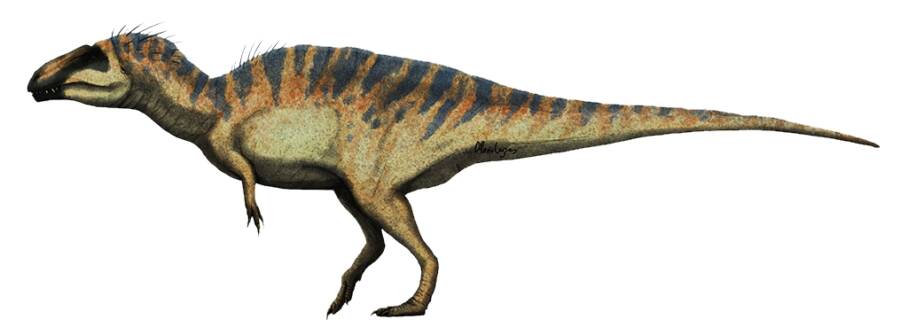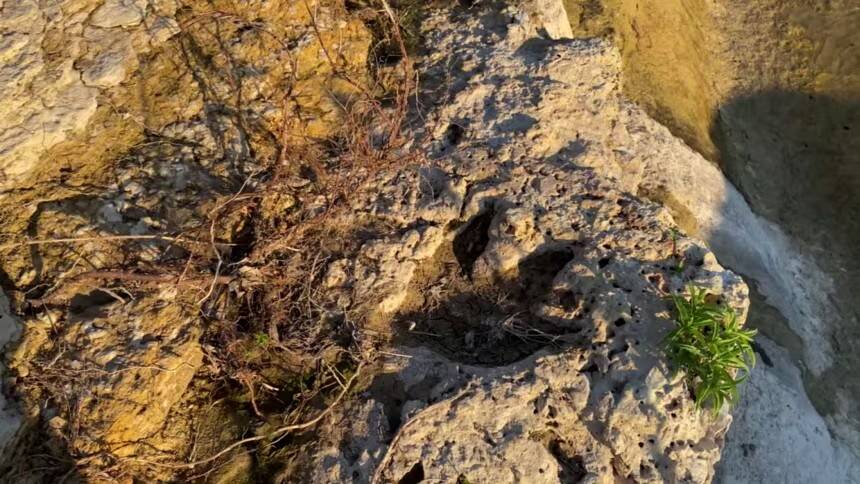Each measuring about 18 to 20 inches long, the tracks are believed to have been made approximately 110 million years ago by an Acrocanthosaurus, a 35-foot-long carnivore.

Carl Stover/CNNThe debris, brush, and sediment washed away by the July floods revealed 15 dinosaur tracks.
The massive floods that swept through Texas this July uncovered 115-million-year-old dinosaur tracks in Travis County. A volunteer discovered the footprints while helping with post-flood clean-up, and so far, 15 tracks have been identified.
Paleontologists had already identified other dinosaur footprints on the same property in the 1980s, further illuminating this site’s prehistoric past.
Texas Floods Reveal 15 Acrocanthosaurus Footprints Near Big Sandy Creek

Wikimedia CommonsPaleontologists believe the tracks were likely made by the Acrocanthosaurus.
The massive, three-toed tracks were found near Big Sandy Creek in central Texas. The brush and sediment washed away by the powerful floods had kept the tracks hidden, according to CNN.
The 15 tracks range from about 18 to 20 inches long, and were formed in 110-million-year-old Glen Rose Formation limestone. Based on the age of the rock, paleontologists estimate the footprints are somewhere between 110 million and 115 million years old.
When the footprints were made, the area that’s now Travis County was located right along the waters of the Western Interior Seaway, an inland sea that split present-day North American in two millions of years ago. Paleontologists believe the tracks could’ve been left by the Acrocanthosaurus, which was the largest carnivore in North America during this period.
Like T. rex, the Acrocanthosaurus could measure up to 35 feet long and had a slender build with small arms. It also had incredibly sharp teeth, allowing it to rip into its prey. While there are important differences between this fearsome carnivore and T. rex, the two are remarkably similar.
“If they were chasing any one of us you wouldn’t be able to tell the difference,” Matthew Brown, paleontologist at the University of Texas at Austin, told KUT News.
Paleontologists also spotted footprints left by Texas’ official state dinosaur, the Paluxysaurus. This large herbivore is characterized by its tall stature and long neck.
The tracks were all found on a piece of private property where, in the 1980s, paleontologists had previously confirmed the presence of other dinosaur tracks.
Plans For Further Study Of The Footprints As Travis County Cleanup Continues

Carl Stover/CNNThis isn’t the first time that dinosaur footprints have been revealed by a natural disaster in Texas.
It is not uncommon for dinosaur tracks to be found in Texas and it is equally common for natural disasters to reveal such footprints. A major drought in 2022 revealed a different set of Acrocanthosaurus footprints near Fort Worth, Texas.
“It’s one of those sort of bittersweet things about our job, is that it’s the cataclysmic events that often preserve fossils in the first place and then also are exposing them,” Brown said.
The floods that swept through central Texas in July claimed at least 135 lives and cleanup is still underway.
The discovery and further study of the dinosaur tracks found in Travis County will not impede these cleanup efforts. Brown and a team of paleontologists from the University of Texas surveyed the tracks on August 5 to better inform authorities on how to continue cleanup while preserving and protecting the tracks.
“That’s the sort of the information that we’ve been providing, just trying to identify positively tracks and then sort of set boundaries around them for the cleanup crews to give them some guidance while they’re working in the area,” Brown explained.
Brown is hoping that further study of the footprints will reveal more about the behavior of Acrocanthosaurus. More specifically, paleontologists hope to figure out if the tracks were made by one dinosaur or a group.
“We are used to new discoveries overturning our long-held ideas on a semiregular basis,” Brown said. “And that’s part of the exciting thing for us, is finding new stuff and having to reframe our perspective.”
After reading about this discovery of Acrocanthosaurus footprints in Texas, take a look at the matching dinosaur footprints found on opposite sides of the Atlantic Ocean. Then, learn about the footprints made by a giant amphibian older than the dinosaurs.





